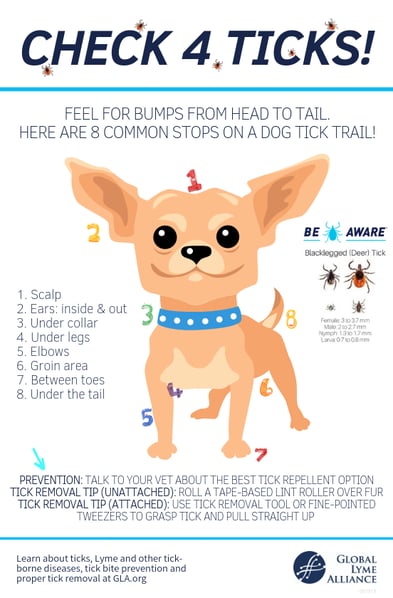
Tick season is upon us, and that means both you and your pets are at risk for Lyme and other tick-borne diseases.
Dogs are particularly prone to tick bites, because they love to play in places where ticks live: grass, shrubs, the woods, leaf piles, and beach dunes. The rate of canine Lyme disease is on the rise, including in states where Lyme was not previously considered endemic. To help keep your dog safe, it’s helpful to understand what Lyme disease is and how it affects dogs; what symptoms you should watch for; how Lyme disease is diagnosed in dogs; and what preventive measures you can take for your dog.
What is Lyme disease?
Lyme disease is a bacterial infection that is transmitted through the bite of a black-legged tick. At first, Lyme bacteria stay localized to the tick bite site, causing mild symptoms. If Lyme is not diagnosed and treated right away, however, the bacteria can move to other parts of a dog’s body such as the joints or kidneys, causing more serious symptoms.
What are common signs and symptoms of Lyme disease in dogs?
Lyme disease can be difficult to detect in both humans and dogs, because symptoms can mirror other illnesses, and can also take a while to develop. In humans, Lyme can be easily detected when a person develops a “bulls-eye” rash, but unfortunately dogs do not get this tell-tale sign of Lyme disease. And of course, since dogs can’t speak, they can’t describe how they’re feeling. Instead, humans need to watch for signs and symptom that could indicate your dog has Lyme disease. Early symptoms of Lyme disease in dogs include:
- Generalized pain
- Fatigue
- Decreased activity
- Loss of appetite
- Fever (often high)
- Lameness—a dog may limp with pain that shifts between legs, and comes and go
- Swollen lymph nodes
- Excessive salivating
If Lyme moves to the joints or kidneys—which could take months or a year before the dog shows symptoms—signs can include:
- Swollen joints
- Vomiting
- Lethargy
- Loss of appetite
- Weight loss
Lyme disease that has moved to a dog’s kidneys can be fatal. If your dog is bitten by a tick, contact your veterinarian right away. Ticks are small and easy to miss, so even if you don’t find one on your dog, it’s important to watch for common symptoms, especially during spring, summer, and fall (though remember that ticks are out any time the temperature is above freezing).
How is Lyme disease diagnosed in dogs?
Lyme disease can be difficult to diagnose because testing is not always accurate. Standard blood tests look for antibodies against the Lyme bacteria, rather than the Lyme bacteria itself. If it’s early in infection, a dog probably won’t have built up enough antibodies to show up on a blood test, meaning the test might have a false negative result. Later-stage cases give dogs more time to build up antibodies, but they still might not create enough to get a positive test result even if they are infected with Lyme. If the test does come back positive, a veterinarian can do a follow-up QC6 test to determine the level of Lyme disease antibodies.
Veterinarians can also test directly for Lyme disease bacteria in joint fluid, but these and other types of tests are also not always accurate and are therefore not often used. If a veterinarian suspects that Lyme disease has moved to a dog’s kidneys, they can run general blood tests to determine kidney function, and urine tests to see if there is loss of protein in the urine.
All of these tests can help a veterinarian make a clinical diagnosis of Lyme disease in dogs, which they may do with or without positive blood test results depending on the dog’s symptoms and their risk of exposure to an infected tick.
How can I protect my dog from Lyme disease?

There are several preventive measures you can take to help protect your dog from Lyme disease. The first is a Lyme disease vaccine, which your veterinarian can administer annually. There are also over-the-counter and prescription products that kill ticks; some are applied topically, some are given orally, and some are part of a collar. These products tend to offer protection for about three months at a time. Talk to your veterinarian about which prevention measure would be best for your dog.
Even if you take one of these prevention measures, it’s still important to check your dog for ticks and watch for symptoms. This is because prevention measures, even the vaccine, are not foolproof. Moreover, the vaccine that prevents Lyme disease does not protect against other tick-borne diseases like anaplasmosis or babesiosis, so your dog could still get one or more infections if they are bitten by a tick.
It’s important to do a tick check on your dog before coming back inside. Check the skin and fur of the dog’s entire body, remembering to look in the scalp, inside and outside the ears, around the eyes and eyelids, under the collar, on the back of the neck, under the legs, in the elbows, in the groin area, between the toes, and under the tail. It can also help to run a lint brush over your dog’s fur to pick up ticks that you might not see or feel.
Though dogs love to run and play, try to keep them out of areas where ticks live by staying on paths; out of long grasses, shrubs, and leaf piles; and out of the woods. You can help protect your pets and yourself from ticks by keeping your lawn short and removing leaf litter.
If you do find a tick on your pet, carefully remove it and then contact your veterinarian.
Click below to read more about Lyme and pets.
New Study Shows Prevalence for Lyme Disease in Dogs Increasing
For more blogs, click here.
The above material is provided for information purposes only. The material (a) is not nor should be considered, or used as a substitute for, medical advice, diagnosis, or treatment, nor (b) does it necessarily represent endorsement by or an official position of Global Lyme Alliance, Inc. or any of its directors, officers, advisors or volunteers. Advice on the testing, treatment or care of an individual patient should be obtained through consultation with a physician who has examined that patient or is familiar with that patient’s medical history.








